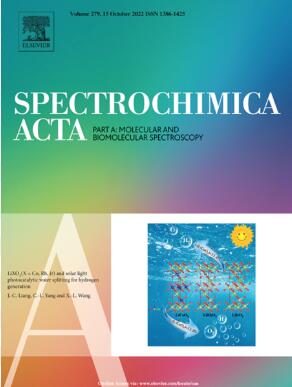Eco-friendly synthesis of a silver nanohybrid with carbon dots derived from Quebracho Colorado leaves and its application in the colorimetric detection of Al3+
IF 4.3
2区 化学
Q1 SPECTROSCOPY
Spectrochimica Acta Part A: Molecular and Biomolecular Spectroscopy
Pub Date : 2025-06-30
DOI:10.1016/j.saa.2025.126628
引用次数: 0
Abstract
The Schinopsis lorentzii tree leaves were utilized for the first time in the production of carbon dots (CDs) with a diameter of 6 nm through hydrothermal carbonization at 200 °C. The heating of AgNO3 aqueous solutions up to 70 °C in the presence of CDs results in the formation of silver nanohybrids (AgNP@CDs), with a zeta potential of −48 mV, a diameter of 33 nm, and a surface plasmon resonance (SPR) absorption band centered at 440 nm. Among the various cations examined, only the incorporation of Al3+ in the AgNP@CDs solution induced a color shift from yellow to brown, leading to the formation of colloidal aggregates with an approximate diameter of 550 nm. The formation of AgNP@CDs nanohybrids and aggregates in the absence and presence of Al3+, respectively, was modeled by combining UV–vis absorption spectra with multivariate curve resolution-alternating least squares (MCR-ALS) analysis. For the AgNP@CDs, a sequential nucleation-aggregation mechanism was observed, with a global activation energy of 28 kJ/mol. In the presence of Al3+, a four-species sequential mechanism describes the progressive formation of larger aggregates, with dose-response curves that are characteristic of highly cooperative binding equilibriums with an average global binding constant of 7 × 104 M−1. The analytical performance of the AgNP@CDs resulted in a sensitivity of 0.03 μM, a linear range between 10 and 20 μM, and a limit of detection of 3.5 μM. These parameters are consistent with those previously reported for the colorimetric determination of Al3+ using AgNPs capped with different molecules.

绿色环保的玉米叶碳点银杂化材料的合成及其在Al3+比色检测中的应用
本文首次利用罗伦芥叶片在200℃下水热炭化制备了直径为6 nm的碳点(CDs)。在CDs存在下,将AgNO3水溶液加热至70°C,形成银纳米杂化体(AgNP@CDs),其zeta电位为- 48 mV,直径为33 nm,表面等离子体共振(SPR)吸收带以440 nm为中心。在检测的各种阳离子中,只有Al3+在AgNP@CDs溶液中的掺入导致颜色从黄色变为棕色,导致形成直径约为550 nm的胶体聚集体。采用紫外-可见吸收光谱和多元曲线分辨率-交替最小二乘(MCR-ALS)分析相结合的方法,模拟了在Al3+不存在和Al3+不存在的情况下AgNP@CDs纳米杂交体和聚集体的形成。对于AgNP@CDs,观察到顺序成核聚集机制,总活化能为28 kJ/mol。在Al3+的存在下,四种顺序机制描述了更大聚集体的逐步形成,其剂量-响应曲线具有高度协同结合平衡的特征,平均全局结合常数为7 × 104 M−1。AgNP@CDs的分析灵敏度为0.03 μM,线性范围为10 ~ 20 μM,检出限为3.5 μM。这些参数与先前报道的用不同分子覆盖的AgNPs比色法测定Al3+的参数一致。
本文章由计算机程序翻译,如有差异,请以英文原文为准。
求助全文
约1分钟内获得全文
求助全文
来源期刊
CiteScore
8.40
自引率
11.40%
发文量
1364
审稿时长
40 days
期刊介绍:
Spectrochimica Acta, Part A: Molecular and Biomolecular Spectroscopy (SAA) is an interdisciplinary journal which spans from basic to applied aspects of optical spectroscopy in chemistry, medicine, biology, and materials science.
The journal publishes original scientific papers that feature high-quality spectroscopic data and analysis. From the broad range of optical spectroscopies, the emphasis is on electronic, vibrational or rotational spectra of molecules, rather than on spectroscopy based on magnetic moments.
Criteria for publication in SAA are novelty, uniqueness, and outstanding quality. Routine applications of spectroscopic techniques and computational methods are not appropriate.
Topics of particular interest of Spectrochimica Acta Part A include, but are not limited to:
Spectroscopy and dynamics of bioanalytical, biomedical, environmental, and atmospheric sciences,
Novel experimental techniques or instrumentation for molecular spectroscopy,
Novel theoretical and computational methods,
Novel applications in photochemistry and photobiology,
Novel interpretational approaches as well as advances in data analysis based on electronic or vibrational spectroscopy.

 求助内容:
求助内容: 应助结果提醒方式:
应助结果提醒方式:


